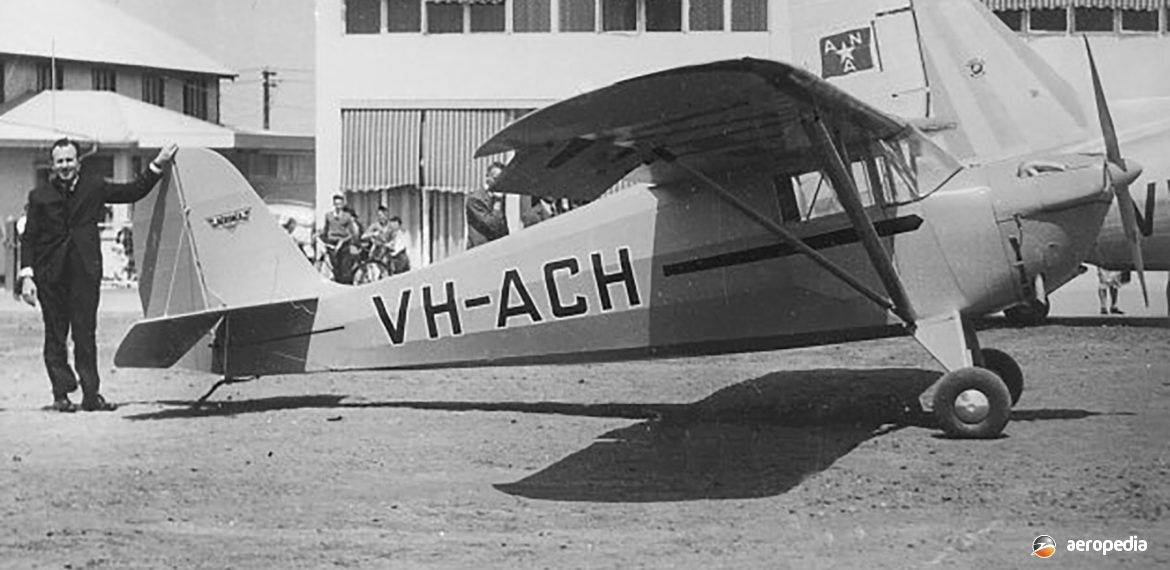Photograph:
Aeronca 50-C Chief VH-ACH (c/n C1618) at Essendon, VIC (Eddie Coates collection)
Country of origin:
United States of America
Description:
Two-seat light sport and touring monoplane
Power Plant:
One 37 kw (50 hp) Continental A-50-1 four-cylinder horizontally-opposed air-cooled engine
Specifications:
- Wingspan: 10.97 m (36 ft)
- Length: 6.41 m (21 ft 1 in)
- Height: 1.92 m (6 ft 3 in)
- Wing area: 15.70 m² (169 sq ft)
- Max speed: 161 km/h (100 mph)
- Cruising speed at 85% power: 145 km/h (90 mph)
- Stalling speed: 58 km/h (36 mph)
- Rate of climb at sea level: 152 m/min (500 ft/min)
- Service ceiling: 3,962 m (13,000 ft)
- Fuel capacity: 45 litres (10 Imp gals)
- Range: 435 km (270 miles)
- Empty weight: 304 kg (670 lb)
- Useful load: 209 kg (460 lb)
- Loaded weight: 513 kg (1,130 lb)
History:
Developed from the Model K series, the Model 50-C, known as the Chief, was powered by a Continental A-50 four-cylinder horizontally-opposed air-cooled engine. It differed from the earlier model in having a wider fuselage, an increase in wing area and all up weight, and other detail changes. The Model K was still in production at that time and at least 350 examples were built. Production of the two models proceeded side-by-side and at least 200 examples of the Model 50-C were built. By 1939 re-design of the A-50 engine showed it delivering 48 kw (65 hp) and this led to a new model known as the Model 65-C. This engine was an improved variant of the A-50 permitted to run at higher rpm and re-rated to 48 kw (65 hp).
The Model 50-C was the first aircraft to be fitted with the A-50 series engine. Airframes were completed at the manufacturer’s facility in the late 1930s awaiting certification of the engine before they could be installed in the aircraft and sold. The Model 50-C series could be fitted with Edo 60-1320 floats, with which it had a max take-off weight of 568 kg (1,253 lb). The Model 65 series was developed from the Model 50 series, with improvements each year, gaining weight as it was developed, the Model 65-CA Super Chief being released in 1941.
However, as World War II progressed, production was suspended and the Company became totally involved in construction for the military. By that time the Aeronautical Corporation of America, based in Cincinnati in Ohio, had produced about 65 examples of the Model K, nearly 200 of the Model 50, and some hundreds of the Model 65 series.
Construction of the fuselage frame was of welded steel tube, faired to shape with wooden formers and fairing strips, and was fabric covered. The Model 50 series had an entry door on the right hand side, with a door on the other side was optional; whereas the Model 65 series had an entry door on each side. The wing framework was built in two pieces of solid spruce spar beams with spruce and plywood truss-type wing ribs. The leading-edge was metal covered and the whole wing was covered with fabric.
Further models in the series were built, the 50-M having the Menasco M-50 Pirate engine, the 50-LA and the 65-LB having a Lycoming engine. During the war the Model 65-C was built for the US Army as the L-3 and, along with similar aircraft from the Taylorcraft and Piper factories, became known as Grasshoppers.
Three aircraft in the series were imported to Australia, and these were: VH-ACH (c/n C1618), a Model 50-C, first registered in January 1939, which was withdrawn from service in December 1947. It was re-registered in October 1956 and eventually withdrawn from service in May 1974. It has been restored in recent years and is now airworthy in Queensland. VH-ACJ (c/n C3059), also a Model 50-C, was first registered in May 1939 but crashed at Toowoomba, QLD on 29 November 1951. VH-ACY (c/n C4919), a Model 65-C, was registered from November 1939 until August 1949 when it was sold to an operator in Sarawak, Malaya and became VR-WAA.

